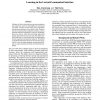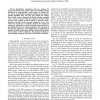165 search results - page 10 / 33 » Cryptographic Complexity Classes and Computational Intractab... |
98
Voted
FLAIRS
2008
15 years 2 months ago
2008
Children are facile at both discovering word boundaries and using those words to build higher-level structures in tandem. Current research treats lexical acquisition and grammar i...
TIFS
2010
14 years 6 months ago
2010
Quantitative steganalysis strives to estimate the change rate defined as the relative number of embedding changes introduced by steganography. In this paper, we propose two new cla...
118
click to vote
ASIACRYPT
2011
Springer
13 years 11 months ago
2011
Springer
The assumption of the availability of tamper-proof hardware tokens has been used extensively in the design of cryptographic primitives. For example, Katz (Eurocrypt 2007) suggests ...
88
Voted
EUROCRYPT
2001
Springer
15 years 4 months ago
2001
Springer
At EuroCrypt’99, Paillier proposed a new encryption scheme based on higher residuosity classes. The new scheme was proven to be one-way under the assumption that computing N-resi...
ISW
2004
Springer
15 years 5 months ago
2004
Springer
Abstract. Chameleon signatures are based on well established hashand-sign paradigm, where a chameleon hash function is used to compute the cryptographic message digest. Chameleon s...


